By Leen Randell
Updated: Jul 04, 2024
10 Best Herbal Decoctions For Headaches

Herbal decoctions for headaches are concentrated liquid extracts made from a combination of herbs, which have been used for centuries to alleviate migraine and tension headache symptoms.
These natural remedies help by releasing endorphins, reducing inflammation, and calming the nervous system. Examples include feverfew and ginger decoctions, which can provide rapid relief from pain and discomfort.
By incorporating herbal decoctions into their daily routine, individuals suffering from frequent headaches can experience improved quality of life, increased energy levels, and reduced reliance on pharmaceuticals.
The following article describes in detail the most important decoctions for headaches, including medicinal properties, parts of herbs to use, and recipes for preparations.
- 1. Ferula foetida
- 2. Valeriana officinalis
- 3. Cinnamomum verum
- 4. Piper nigrum
- 5. Hypericum perforatum
- 6. Melissa officinalis
- 7. Matricaria chamomilla
- 8. Achillea millefolium
- 9. Ginkgo biloba
- 10. Rosmarinus officinalis
- What is the best combination of herbal decoctions to use for headaches?
- What ailments similar to headaches are treated with herbal decoctions?
1. Ferula foetida
Asafoetida decoctions helps with headaches because of its unique combination of bioactive compounds, particularly the sulfur-containing molecules that have a natural analgesic and anti-inflammatory effect.
The decoction's potent antispasmodic properties help to relax tense muscles and blood vessels in the neck and head, reducing pain and discomfort caused by migraines and tension headaches.
Additionally, asafoetida's ability to stimulate digestion and reduce inflammation may also contribute to its headache-relieving effects by addressing underlying digestive issues that can exacerbate headache symptoms.
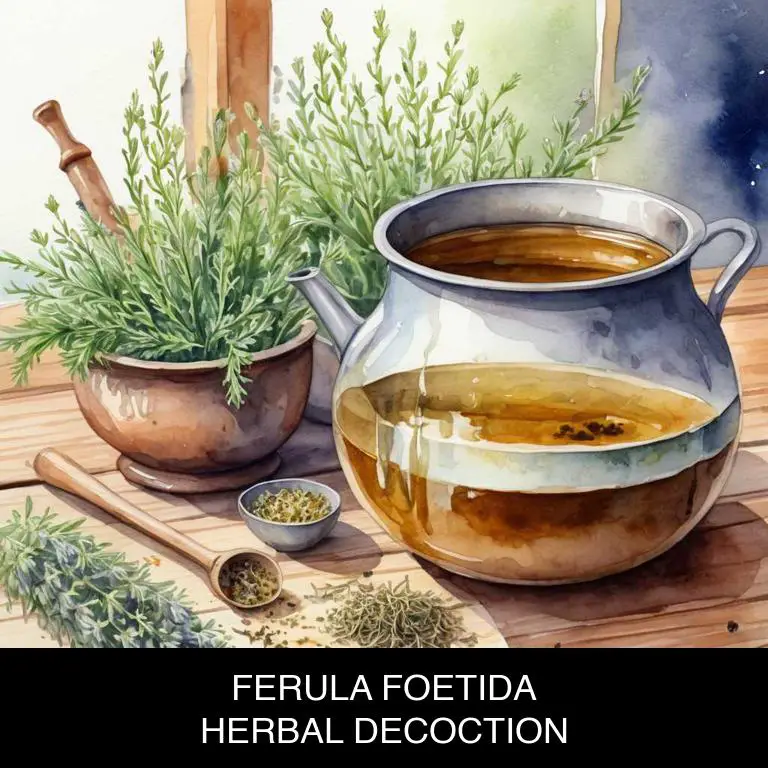
Medicinal Constituents
The list below shows the primary medicinal constituents in Ferula foetida decoctions that help with headaches.
- Asafoetida: Asafoetida contains compounds that have anti-inflammatory and analgesic properties, which can help alleviate headache pain and reduce inflammation associated with headaches.
- Ferulic acid: Ferulic acid has antioxidant and anti-inflammatory properties, which can help reduce oxidative stress and inflammation that may contribute to headache development.
- Bornyl acetate: Bornyl acetate has analgesic and anti-inflammatory properties, which can help relieve headache pain and reduce inflammation associated with headaches.
Parts Used
The list below shows the primary parts of asafoetida used to make decoctions for headaches.
- Roots: Roots are commonly used to make decoctions for headaches due to their high concentration of medicinal properties.
- Rhyzomes: Rhyzomes are used in decoctions for headaches because they contain active compounds that help alleviate pain.
- Barks: Barks are often used to make decoctions for headaches due to their ability to relax and soothe the nervous system.
Quick Recipe
The following recipe gives a procedure to make a basic asafoetida for headaches.
- Harvest 10-20 grams of dried ferula foetida roots with a sharp knife and store in an airtight container.
- Grind the roots into a fine powder using a mortar and pestle for 5 minutes.
- Mix 1 gram of the powder with 100 milliliters of boiling water in a heat-resistant cup.
- Steep the mixture for 10-15 minutes to allow the active compounds to infuse into the water.
- Strain the decoction through a cheesecloth or a coffee filter into a clean container.
2. Valeriana officinalis
Valerian decoctions helps with headaches because it has a profound impact on the body's nervous system.
The herbal remedy has been used for centuries to promote relaxation, reduce anxiety, and alleviate stress, which are all common triggers of headaches. By calming the mind and body, valerian decoctions can help to ease tension and pressure in the head and neck, providing relief from pain and discomfort.
Additionally, its sedative properties can help to reduce inflammation and swelling in the brain, further contributing to headache alleviation.
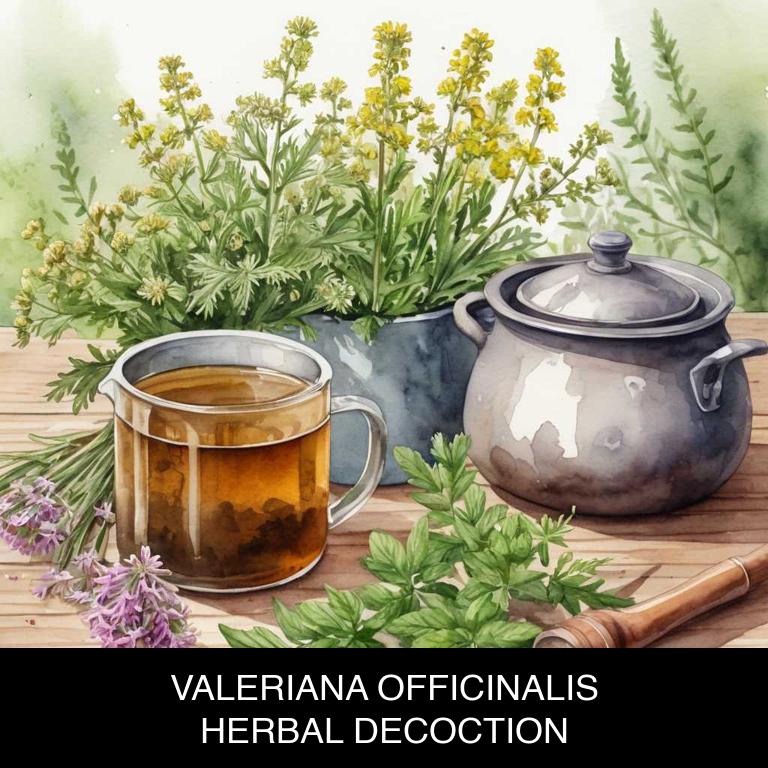
Medicinal Constituents
The list below shows the primary medicinal constituents in Valeriana officinalis decoctions that help with headaches.
- Valerenic acid: Valerenic acid is a sesquiterpene that acts as a GABA receptor agonist, which can help reduce anxiety and stress-related headaches by promoting relaxation and calmness.
- Isovaleric acid: Isovaleric acid, an organic compound and volatile oil, has analgesic and anti-inflammatory properties that can help alleviate headache pain and reduce inflammation associated with headaches.
- Valeranone: Valeranone, a sesquiterpene, has a sedative effect and can help reduce anxiety and stress, which can contribute to headaches such as migraines and tension headaches.
Parts Used
The list below shows the primary parts of valerian used to make decoctions for headaches.
- Roots: They are the most commonly used part due to their high concentration of valerenic acid, a compound with sedative and pain-relieving properties.
- Leaves: They are used in decoctions to provide additional relief from headaches and other anxiety-related symptoms, although their effect is generally milder than that of the roots.
Quick Recipe
The following recipe gives a procedure to make a basic valerian for headaches.
- Harvest 50-100 grams of dried valeriana officinalis roots during the fall season when the plant is mature.
- Cut the dried roots into small pieces and store them in an airtight container for later use.
- Combine 1-2 teaspoons of the dried root pieces with 250 milliliters of boiling water in a saucepan.
- Steep the mixture for 5-10 minutes and then strain it through a cheesecloth or a fine-mesh sieve.
- Discard the solids and let the decoction cool before consuming it as a tea or storing it in the refrigerator.
3. Cinnamomum verum
Ceylon cinnamon decoctions helps with headaches because of its potent anti-inflammatory properties, which effectively alleviate pain and discomfort.
The decoction's active compounds, such as cinnamaldehyde, have been shown to reduce inflammation in the body, providing relief from migraine and tension headaches. Additionally, Ceylon cinnamon has natural analgesic and antispasmodic properties that help relax muscle contractions and ease throbbing sensations associated with headache pain.
By soothing and calming the body's inflammatory response, Ceylon cinnamon decoctions provide a natural remedy for headache relief.
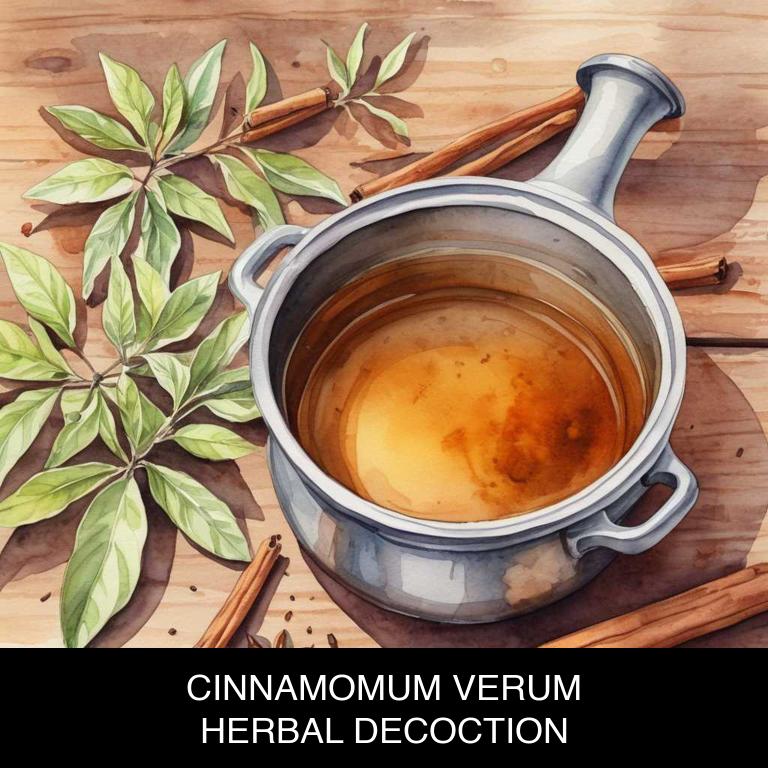
Medicinal Constituents
The list below shows the primary medicinal constituents in Cinnamomum verum decoctions that help with headaches.
- Cinnamaldehyde: A major terpene compound in Cinnamomum verum, cinnamaldehyde has analgesic and anti-inflammatory properties, helping to reduce pain and swelling associated with headaches.
- Linalool: A terpene compound with anti-inflammatory and antispasmodic properties, linalool helps to relax muscle tension and reduce inflammation in blood vessels, alleviating headache symptoms.
- Eugenol: A phenolic compound with analgesic and anti-inflammatory properties, eugenol helps to block the production of pain-causing chemicals and reduce inflammation in the brain, providing relief from headaches.
Parts Used
The list below shows the primary parts of ceylon cinnamon used to make decoctions for headaches.
- Rhyzomes: Cinnamomum verum rhyzomes are used to make decoctions for headaches because they contain cinnamaldehyde, a compound with analgesic and anti-inflammatory properties.
- Leaves: Cinnamomum verum leaves are used to make decoctions for headaches because they have been traditionally used to relieve pain and reduce fever.
- Barks: Cinnamomum verum barks are used to make decoctions for headaches because they contain oils with anti-inflammatory properties that may help alleviate headache symptoms.
Quick Recipe
The following recipe gives a procedure to make a basic ceylon cinnamon for headaches.
- Gather 2-3 grams of dried cinnamomum verum bark and 1 liter of water for preparation.
- Boil the water for 5-7 minutes to reach a rolling boil state.
- Add the cinnamomum verum bark to the boiling water and reduce heat to a simmer.
- Steep the mixture for 10-15 minutes to allow for optimal flavor and oil extraction.
- Strain the decoction and discard the solids to obtain the final herbal tea solution.
4. Piper nigrum
Black pepper decoctions helps with headaches because it contains piperine, a compound that has potent anti-inflammatory and pain-relieving properties.
When consumed as a tea or infusion, black pepper decoctions can help to relax tense muscles and blood vessels, reducing the frequency and severity of migraines and tension headaches.
Additionally, the bioactive compounds in black pepper may also help to improve blood circulation, which can further alleviate headache symptoms by reducing inflammation and promoting healing.
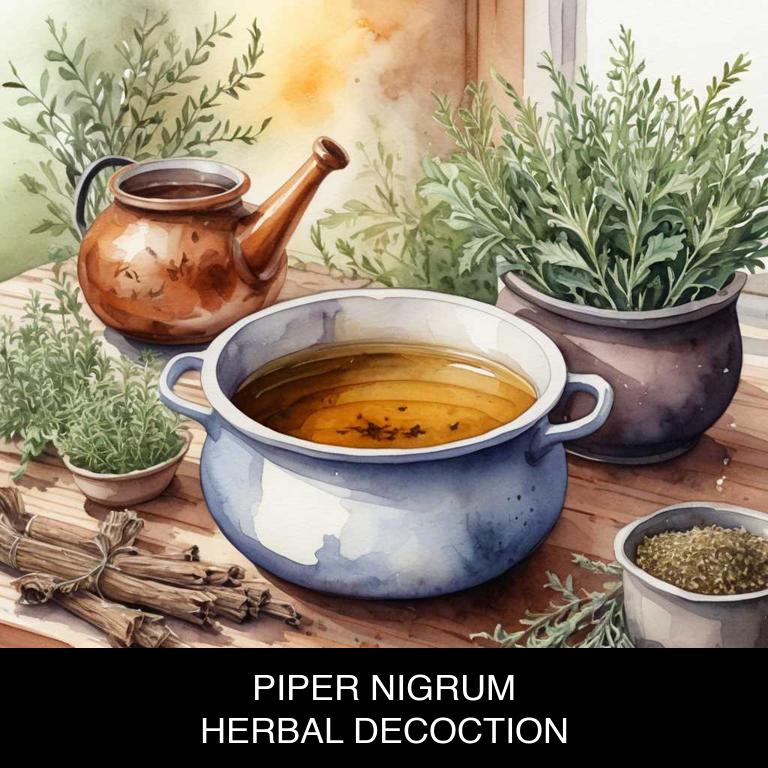
Medicinal Constituents
The list below shows the primary medicinal constituents in Piper nigrum decoctions that help with headaches.
- Piperine: Piperine, a bioactive compound found in Piper nigrum, has anti-inflammatory and analgesic properties, which help alleviate headache symptoms by reducing pain and inflammation in the brain and nervous system.
- Terpinen-4-ol: Terpinen-4-ol, a monoterpene found in Piper nigrum, exhibits anti-inflammatory and antioxidant properties, which help prevent headaches by reducing oxidative stress and inflammation in the brain, thereby alleviating pain and discomfort.
- Caryophyllene: Caryophyllene, a sesquiterpene found in Piper nigrum, has anti-inflammatory and neuroprotective properties, which help prevent headaches by reducing inflammation and oxidative stress in the brain, thus alleviating pain and promoting overall brain health.
Parts Used
The list below shows the primary parts of black pepper used to make decoctions for headaches.
- Seeds: Piper nigrum seeds contain piperine, which has analgesic and anti-inflammatory properties that help alleviate headache pain.
- Leaves: The leaves of Piper nigrum are used to make decoctions due to their ability to reduce fever and relieve tension, which can contribute to headache symptoms.
- Buds: Piper nigrum buds are used in traditional medicine to treat headaches due to their potential anti-inflammatory and analgesic effects, which can help reduce pain and inflammation associated with headaches.
Quick Recipe
The following recipe gives a procedure to make a basic black pepper for headaches.
- Harvest 20 grams of fresh piper nigrum berries and rinse them thoroughly with filtered water.
- Dry the berries in a low-temperature oven at 50 degrees celsius for 2 hours.
- Grind the dried berries into a fine powder using a spice grinder.
- Mix the powder with 250 milliliters of boiling water to create a decoction.
- Steep the mixture for 10 to 15 minutes before straining it through a cheesecloth.
5. Hypericum perforatum
St john's wort decoctions helps with headaches because of its unique composition, which contains hyperforin and hypericin.
These bioactive compounds have anti-inflammatory and analgesic properties that effectively alleviate tension and pain in the head. The decoction's antispasmodic effects also help to relax muscle contractions, reducing the severity of migraine attacks.
Additionally, St john's wort's natural sedative properties can promote relaxation, helping to calm the mind and body, further alleviating headache symptoms.

Medicinal Constituents
The list below shows the primary medicinal constituents in Hypericum perforatum decoctions that help with headaches.
- Hyperforin: Acts as a serotonin reuptake inhibitor, which helps to increase serotonin levels in the brain, thereby reducing pain and inflammation associated with headaches.
- Hypericin: Exhibits analgesic and anti-inflammatory properties, reducing pain and swelling in the head and neck, which can contribute to headache relief.
- Quercetin: A flavonoid with potent anti-inflammatory and antioxidant properties, which can help reduce inflammation and oxidative stress in the body, potentially alleviating headache symptoms.
Parts Used
The list below shows the primary parts of st john's wort used to make decoctions for headaches.
- Leaves: The leaves contain hypericin and hyperforin, which have anti-inflammatory and analgesic properties, helping to relieve headache pain.
- Flowers: The flowers have a high concentration of hypericin and hyperforin, making them a popular choice for decoctions to treat headaches and promote relaxation.
- Buds: The buds are rich in bioactive compounds, including flavonoids and phenolic acids, which have anti-inflammatory and antioxidant properties, helping to reduce headache severity.
Quick Recipe
The following recipe gives a procedure to make a basic st john's wort for headaches.
- Gather 30-60 grams of dried hypericum perforatum flowers and leaves from a trusted source.
- Measure out 1 teaspoon of the dried herb for every 8 ounces of water.
- Combine the measured herb with boiling water in a heat-resistant container.
- Steep the mixture for 10 to 15 minutes to allow the active compounds to infuse.
- Strain the decoction through a fine-mesh sieve or cheesecloth to remove the solids.
6. Melissa officinalis
Lemon balm decoctions helps with headaches because of its natural calming and analgesic properties.
The herb contains rosmarinic acid, which has been shown to reduce inflammation and relax muscles, providing relief from tension headaches. Additionally, lemon balm's soothing effects on the nervous system can help alleviate migraines by reducing stress and anxiety triggers.
By promoting relaxation and reducing pain sensitivity, herbal lemon balm decoctions offer a natural solution for alleviating headache discomfort and improving overall well-being.
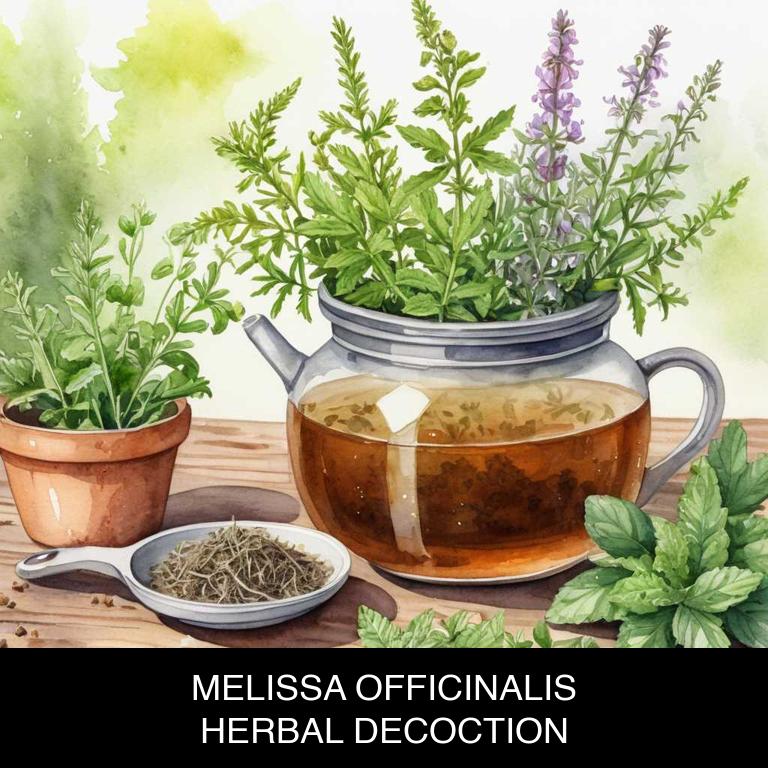
Medicinal Constituents
The list below shows the primary medicinal constituents in Melissa officinalis decoctions that help with headaches.
- Rosmarinic acid: A phenolic compound with anti-inflammatory and antioxidant properties that helps alleviate headache symptoms by reducing inflammation and oxidative stress in the brain.
- Luteolin: A flavonoid with anti-inflammatory and antispasmodic properties that helps ease headache pain by relaxing smooth muscle contractions and reducing inflammation in blood vessels.
- Melissic acid: A triterpene with analgesic and anti-inflammatory properties that helps relieve headache pain by blocking pain pathways in the brain and reducing inflammation in affected areas.
Parts Used
The list below shows the primary parts of lemon balm used to make decoctions for headaches.
- Leaves: They contain compounds like citral and linalool, which have analgesic and anti-inflammatory properties, helping to relieve headache symptoms.
- Stems: The stems of Melissa officinalis also contain essential oils and bioactive compounds that contribute to its pain-relieving and anti-inflammatory effects.
- Roots: The roots of the plant are known to have a more concentrated amount of essential oils and bioactive compounds, making them effective for treating headaches.
Quick Recipe
The following recipe gives a procedure to make a basic lemon balm for headaches.
- Harvest 20-30 grams of melissa officinalis leaves and flowers and clean them thoroughly to remove any dirt or debris.
- Boil 1 liter of water for 5 minutes to create a hot water bath for the melissa officinalis.
- Add the cleaned melissa officinalis to the boiling water and reduce heat to low for 10-15 minutes.
- Strain the decoction through a cheesecloth or a fine-mesh sieve into a clean container to remove solids.
- Store the decoction in a refrigerator for up to 24 hours before consumption.
7. Matricaria chamomilla
Chamomile decoctions helps with headaches because of its soothing and calming properties.
The apigenin, an active compound in chamomile, binds to GABA receptors in the brain, promoting relaxation and reducing inflammation. This natural sedative effect helps alleviate tension and stress-induced headaches by relaxing muscle contractions and improving blood flow to the head and neck.
As a result, chamomile decoctions can provide quick relief from headache symptoms, providing a calming and peaceful sensation that promotes overall well-being.

Medicinal Constituents
The list below shows the primary medicinal constituents in Matricaria chamomilla decoctions that help with headaches.
- Apigenin: This flavonoid acts as a potent anti-inflammatory agent, reducing inflammation and pain associated with headaches.
- Bisabolol: This sesquiterpene lactone has analgesic and anti-inflammatory properties, helping to relieve headache pain and soothe the nervous system.
- Luteolin: This flavonoid exhibits strong anti-inflammatory and antioxidant activities, which can help alleviate headache symptoms and reduce oxidative stress.
Parts Used
The list below shows the primary parts of chamomile used to make decoctions for headaches.
- Flowers: They are the most widely used part due to their high concentration of apigenin and chamazulene, which have anti-inflammatory and pain-relieving properties.
- Leaves: Leaves are used for their mild sedative and anti-inflammatory effects, which can help soothe headaches and promote relaxation.
- Roots: Roots contain sesquiterpene lactones, which have analgesic and anti-inflammatory properties, making them effective in reducing headache pain and inflammation.
Quick Recipe
The following recipe gives a procedure to make a basic chamomile for headaches.
- Gather 2 tablespoons of dried matricaria chamomilla flowers in a clean glass container.
- Combine the dried flowers with 1 quart of boiling water in a heat-resistant glass measuring cup.
- Steep the mixture for 5 to 10 minutes to allow the herbal properties to infuse.
- Strain the liquid through a cheesecloth or a fine-mesh sieve into a clean glass container.
- Discard the solids and let the decoction cool to room temperature for later use.
8. Achillea millefolium
Yarrow decoctions helps with headaches because of its ability to relieve tension and reduce inflammation in the body.
The plant's active compounds, such as chamazulene and sesquiterpene lactones, work together to calm the nerves and relax muscle contractions that can contribute to pain. Additionally, yarrow's anti-inflammatory properties help to reduce swelling and pressure on blood vessels, which can also alleviate headache symptoms.
By promoting relaxation and reducing inflammation, herbal yarrow decoctions provide natural relief from headaches and migraines.

Medicinal Constituents
The list below shows the primary medicinal constituents in Achillea millefolium decoctions that help with headaches.
- Apigenin: An isocoumarin with anti-inflammatory and sedative properties, which can help alleviate headache symptoms by reducing inflammation and promoting relaxation.
- Nepetalactone: A sesquiterpene lactone with a sedative effect, which can help with headaches by inducing a calming effect on the nervous system and reducing stress.
- Cichoriin: A sesquiterpene lactone with anti-inflammatory and analgesic properties, which can help with headaches by reducing inflammation and pain in the body.
Parts Used
The list below shows the primary parts of yarrow used to make decoctions for headaches.
- Leaves: The leaves are used due to their high concentration of essential oils, which have anti-inflammatory and antispasmodic properties to help alleviate headache symptoms.
- Roots: The roots are used for their medicinal properties, including their ability to relax muscles and reduce pain, making them effective in treating tension headaches.
- Flowers: The flowers are used due to their flavonoids and essential oils, which have anti-inflammatory and analgesic properties to help soothe and calm headache pain.
Quick Recipe
The following recipe gives a procedure to make a basic yarrow for headaches.
- Harvest 25-30 grams of dried achillea millefolium leaves and flowers from a trusted source.
- Crush the dried plant material into a fine powder using a mortar and pestle.
- Combine the powdered achillea millefolium with 500 milliliters of boiling water in a heat-resistant container.
- Steep the mixture for 5-7 minutes or until the liquid has reduced slightly.
- Strain the decoction through a cheesecloth or fine-mesh sieve into a clean container.
9. Ginkgo biloba
Maidenhair tree decoctions helps with headaches because it contains compounds like salicin, a natural analgesic that provides relief from pain.
The decoction's anti-inflammatory properties also help reduce swelling and pressure in the blood vessels, which can contribute to headache severity. Additionally, the calming effects of maidenhair tree decoctions may help alleviate stress and anxiety, common triggers for headaches.
By soothing the body and mind, maidenhair tree decoctions can provide natural relief from headache discomfort.

Medicinal Constituents
The list below shows the primary medicinal constituents in Ginkgo biloba decoctions that help with headaches.
- Flavonoids: These plant compounds help alleviate headaches by reducing inflammation and improving blood flow to the brain, thus relieving pain and discomfort.
- Bilobalide: A triterpene derived from Ginkgo biloba, bilobalide has been shown to have neuroprotective properties, which may help reduce the frequency and severity of headaches by shielding the brain from oxidative stress and inflammation.
- Quercetin: A type of flavonoid, quercetin has potent anti-inflammatory and antioxidant properties, which can help reduce the severity of headache symptoms by blocking the production of pain-causing chemicals in the body.
Parts Used
The list below shows the primary parts of maidenhair tree used to make decoctions for headaches.
- Leaves: The leaves of Ginkgo biloba are rich in flavonoids and terpenoids, which are believed to have anti-inflammatory and antioxidant properties that can help alleviate headache symptoms.
- Seeds: The seeds of Ginkgo biloba are known for their unique ability to inhibit the formation of pro-inflammatory mediators, which can contribute to headache relief.
- Barks: The barks of Ginkgo biloba are used in traditional medicine to treat various health issues, including headaches, due to their high content of flavonoids and other bioactive compounds that have anti-inflammatory and antioxidant properties.
Quick Recipe
The following recipe gives a procedure to make a basic maidenhair tree for headaches.
- Measure out 2-4 grams of dried ginkgo biloba leaves or 3-6 grams of fresh leaves.
- Combine the measured ginkgo biloba with 250 milliliters of cold water in a saucepan.
- Bring the water to a boil over high heat then reduce the heat to medium.
- Simmer the mixture for 10-30 minutes or until the liquid has reduced by half.
- Strain the decoction through a cheesecloth or fine-mesh sieve into a clean container.
10. Rosmarinus officinalis
Rosemary decoctions helps with headaches because of its ability to improve blood circulation, relax tense muscles, and ease inflammation.
The antioxidant properties in rosemary also help reduce oxidative stress and free radical damage that can contribute to headache development.
Additionally, rosemary's natural analgesic and anti-inflammatory compounds work together to provide fast and effective relief from tension and migraine headaches.
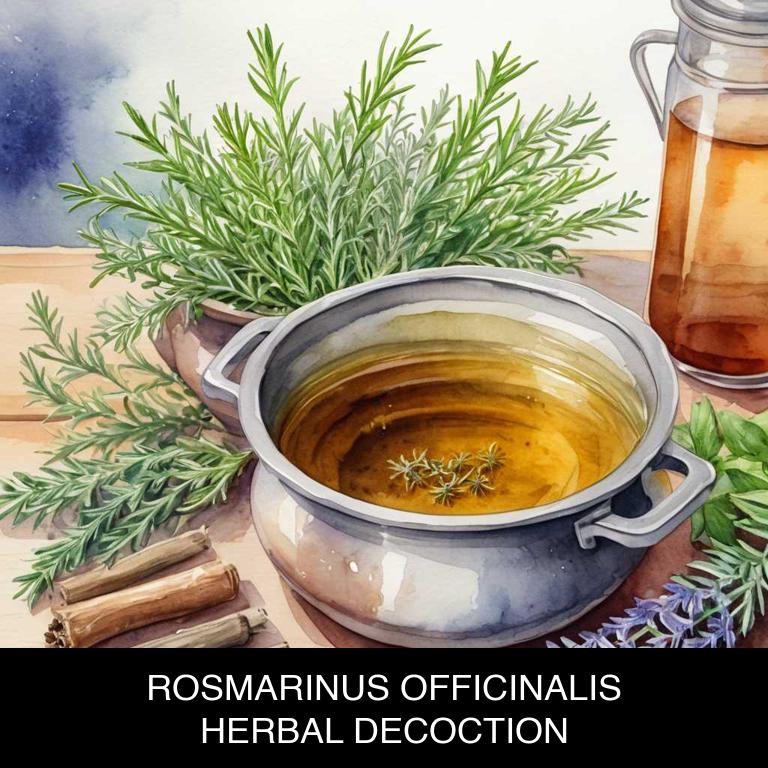
Medicinal Constituents
The list below shows the primary medicinal constituents in Rosmarinus officinalis decoctions that help with headaches.
- Rosmarinic acid: A polyphenolic compound that has anti-inflammatory and antioxidant properties, helping to reduce pain and inflammation associated with headaches.
- Carnosic acid: A phenolic diterpene that has potent antioxidant and anti-inflammatory effects, which can help alleviate headache symptoms by reducing oxidative stress and inflammation in the brain.
- Bornyl acetate: A monoterpene that has analgesic and anti-inflammatory properties, helping to relieve pain and discomfort associated with headaches by inhibiting the production of pain-related chemicals in the brain.
Parts Used
The list below shows the primary parts of rosemary used to make decoctions for headaches.
- Leaves: Used for decoctions due to their high concentration of essential oils, which have analgesic and anti-inflammatory properties.
- Flowers: Employed for decoctions due to their content of flavonoids and volatile oils, which help in reducing pain and inflammation associated with headaches.
- Buds: Utilized for decoctions because they contain a higher concentration of essential oils compared to the mature leaves, providing effective relief from headaches.
Quick Recipe
The following recipe gives a procedure to make a basic rosemary for headaches.
- Harvest 30g of fresh rosmarinus officinalis leaves or 10g of dried leaves for decoction preparation.
- Combine the rosmarinus officinalis leaves with 500ml of water in a saucepan and bring to a boil.
- Reduce heat to a simmer and let the mixture steep for 10-15 minutes or until the desired strength.
- Strain the decoction through a cheesecloth or a fine-mesh sieve into a clean container.
- Store the rosmarinus officinalis decoction in the refrigerator and use within 3 days or freeze for later use.
What is the best combination of herbal decoctions to use for headaches?
The best combination of herbal decoctions that help with headaches is a blend of feverfew, ginger, and peppermint.
Feverfew is known for its ability to reduce inflammation and alleviate migraine pain, while ginger helps to calm nausea and soothe digestive issues often associated with headaches. Peppermint, with its cooling properties, provides relief from tension and eases the pain.
These three decoctions, when combined, can provide a powerful and natural remedy for various types of headaches.
What ailments similar to headaches are treated with herbal decoctions?
Ailments similar to headaches that are treated with herbal decoctions are migraines, sinusitis, and tension.
Herbs like feverfew, ginger, and turmeric have anti-inflammatory properties that help alleviate pain and reduce inflammation in the head and sinuses.
Other herbs like passionflower, valerian root, and skullcap can also be used to treat anxiety and stress-related headaches, promoting relaxation and calming the mind and body.